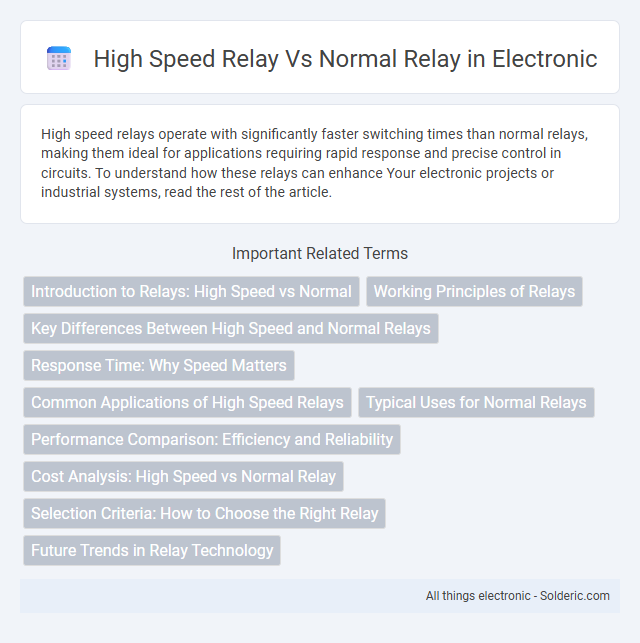High speed relays operate with significantly faster switching times than normal relays, making them ideal for applications requiring rapid response and precise control in circuits. To understand how these relays can enhance Your electronic projects or industrial systems, read the rest of the article.
Comparison Table
| Feature | High Speed Relay | Normal Relay |
|---|---|---|
| Switching Speed | Microseconds to milliseconds | Milliseconds to tens of milliseconds |
| Typical Use | Fast switching applications, signal processing, automation | General-purpose switching, low-speed control circuits |
| Contact Material | Silver alloys, gold plating for low resistance | Common metals like silver or copper alloys |
| Power Consumption | Lower coil power in advanced designs | Standard coil power levels |
| Durability | High number of operations (millions) | Lower mechanical lifespan (thousands to hundreds of thousands) |
| Cost | Higher due to advanced materials and design | Lower, suitable for cost-sensitive applications |
| Applications | Telecommunications, automotive electronics, industrial automation | Household appliances, lighting control, simple circuits |
Introduction to Relays: High Speed vs Normal
High speed relays offer significantly faster switching times compared to normal relays, enabling quicker response in time-sensitive applications such as telecommunications and industrial automation. Normal relays typically handle general-purpose switching tasks with slower response rates, making them suitable for less demanding environments. Understanding the distinction between high speed and normal relays helps you select the appropriate device for your specific performance and reliability requirements.
Working Principles of Relays
High-speed relays operate using electromagnetic or solid-state mechanisms designed for rapid switching, achieving response times in the microsecond to millisecond range, whereas normal relays typically rely on slower electromagnetic coils that actuate mechanical contacts. The faster actuation in high-speed relays minimizes contact bounce and increases switching precision, crucial for applications requiring quick and repetitive operations. Understanding these differences helps you select the right relay based on timing requirements and operational efficiency.
Key Differences Between High Speed and Normal Relays
High speed relays operate at switching speeds typically under 1 millisecond, significantly faster than normal relays which switch in 5 to 20 milliseconds, making them ideal for applications requiring rapid response like telecommunications and industrial automation. High speed relays use advanced coil designs and low inertia armatures to minimize contact bounce and increase switching accuracy, whereas normal relays prioritize cost-effectiveness and broad compatibility. Understanding these key differences helps you select the most efficient relay type to optimize your system's performance and reliability.
Response Time: Why Speed Matters
High speed relays offer significantly faster response times, typically measured in microseconds, compared to normal relays which operate in milliseconds. Faster response times reduce switching delays, crucial for applications requiring precise timing such as industrial automation, telecommunications, and high-speed data acquisition. The ability to switch quickly minimizes signal distortion and increases system reliability in time-sensitive environments.
Common Applications of High Speed Relays
High speed relays are commonly used in telecommunications equipment, automotive systems, and industrial automation where rapid switching response is critical. They are essential in protecting electrical circuits by quickly interrupting fault currents in power systems and enabling precise control in high-frequency signal processing. High speed relays improve reliability in applications such as robotic controls, medical devices, and pulse counting systems by minimizing delay and enhancing operational efficiency.
Typical Uses for Normal Relays
Normal relays are commonly used in applications requiring general-purpose switching such as controlling lighting systems, motor starters, and home appliances due to their reliable performance and cost-effectiveness. These relays are suitable for handling moderate switching speeds and currents, making them ideal for tasks that do not demand rapid operation or high-frequency switching. Your choice of a normal relay ensures stable and durable control in everyday electrical and automation systems where speed is not a critical factor.
Performance Comparison: Efficiency and Reliability
High speed relays deliver superior switching efficiency by minimizing contact bounce and reducing response times compared to normal relays, which enhances overall system performance and reduces energy consumption. Their reliability is elevated through advanced design features that withstand frequent operations and harsh conditions, whereas normal relays may experience faster wear and contact degradation under similar loads. When optimizing Your system for critical applications requiring rapid, consistent switching, high speed relays offer a more dependable and efficient solution.
Cost Analysis: High Speed vs Normal Relay
High speed relays generally come at a higher initial cost compared to normal relays due to advanced materials and faster switching mechanisms. However, their increased lifespan and reduced downtime can lead to lower long-term operational expenses in critical applications. You should weigh the upfront investment against potential savings in maintenance and efficiency for your specific use case.
Selection Criteria: How to Choose the Right Relay
When selecting between a high speed relay and a normal relay, consider switching speed requirements, load type, and application environment. High speed relays offer rapid response times ideal for precise control in automation and signal processing, while normal relays suit general-purpose switching with moderate speed demands. Evaluating factors such as contact rating, coil voltage, durability, and electromagnetic interference resistance ensures optimal relay performance and longevity.
Future Trends in Relay Technology
High speed relays, essential for rapid switching in automation and telecommunications, are evolving with advancements in solid-state technology and miniaturization. Future trends emphasize integration with IoT devices and enhanced energy efficiency, surpassing the slower response times and mechanical wear limitations of normal relays. Innovations in materials and design aim to increase durability and switching frequency, positioning high speed relays as critical components in next-generation smart grid and industrial applications.
high speed relay vs normal relay Infographic

 solderic.com
solderic.com